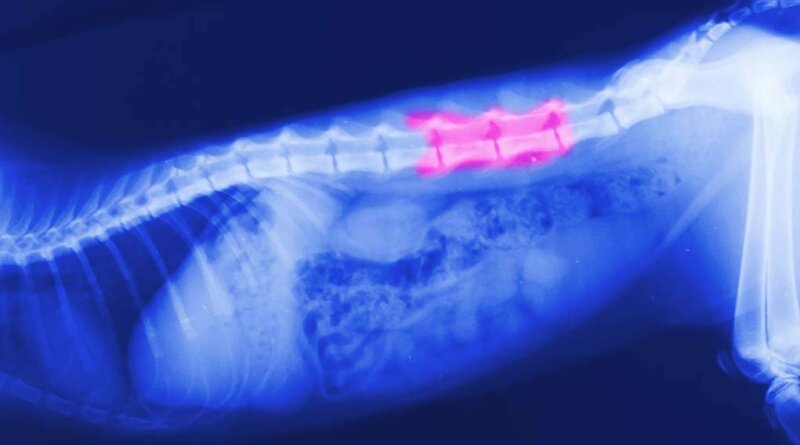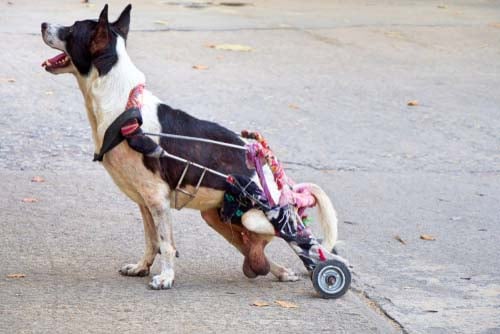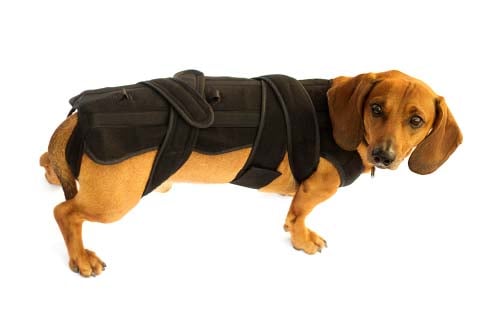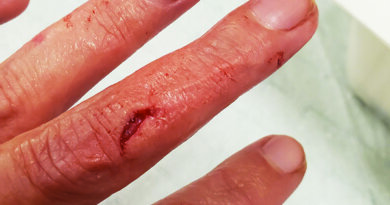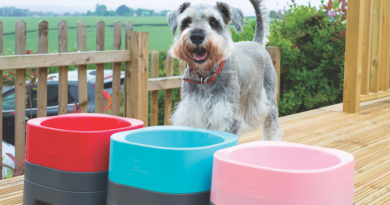7 Common Dog Spine Problems: Causes, Prevention and Treatment
Spinal problems in dogs are more common than most owners realize. Typically, they take time to develop before the symptoms become apparent and the dog’s behavior changes, but it can seriously impact a dog’s quality of life. Below we’ll look at the most common signs of dog spine problems, and what you can do to prevent and fix these issues.
Common Signs of Dog Spine Problems
There are several types of spinal problems in dogs, and symptoms vary depending on the cause and the severity of the condition. Some of the most common signs are below.
Inability to Move Naturally
The easiest way to spot a spinal problem in your dog is by paying attention to your pet’s posture and movement, like rear limb weakness and indication of pain, and signs of “spinal stroke“, all of which you may notice when the dog has trouble climbing stairs or getting into a car.
The dog may also start to drag their rear legs, which is often accompanied by tail dropping and hunched back. Other signs include problems with lying down or getting up, unwillingness to move or jump, and limping.
Signs of Pain
While some cases of dog spine problems can be painless for the dog, mostly they are accompanied by some type of pain or stiffness in the dog’s back or neck. When the pain becomes too strong, dogs usually cry out or vocalize their pain in other ways.
Neurological Problems
Neurological problems related to spine conditions in dogs include loss of balance and coordination, loss of muscle mass and muscle spasms over the dog’s back and neck, and complete muscle atrophy.
In more extreme cases, even the inability to feel pain or paralysis can occur. Loss of bowel or bladder control, also called incontinence, can be another clear sign of dog spinal problems.
Other Symptoms
You may notice some changes in your dog’s behavior, such as the dog developing a more anxious behavior and becoming sensitive to movement and even noises, reduced activity level and decreased appetite. Rapid breathing and shivering can also suggest spinal problems, and levels of stress in the dog can also be clearly observed.
There are many potential causes of these canine spine problems. While some are neurological, others will be a result of inflammation or caused by viral, bacterial and fungal infections. Below are the most common causes of dog spine problems.
Causes of Dog Spine Problems
1. Trauma or Injury
The most common cause of spinal problems in dogs is trauma. The trauma can be caused by a fall or an accident, although the more common causes include everyday activities like jumping for balls and particularly bad posture. Spinal cord injuries mostly occur as a result of a spinal dislocation or fraction.
However, the injury doesn’t have to be recent. The origin of the spinal problem can happen years before symptoms show up. Symptoms of spinal trauma in the dog usually show up suddenly and can be severe and worsen progressively.
How to Prevent It:
There is no single way to prevent any kind of injuries in dogs. Keep your pooch safe from traffic and cars since car accidents are one of the leading causes of injuries in dogs. Whenever playing or training with your dog, practice safety and be cautious.
Other than that, ensure that your pup has the right posture and don’t work him too hard during exercise or play. Sometimes dogs do not realize when they’re overworked, and you’ll have to do this guess work for them.
How to Fix It:
If you notice that your canine is limping or shows any other signs of spinal problems, take him to the vet immediately. Your vet will notice any fractures or dislocations on x-rays or CT scan, if the pet’s problems are caused by trauma or injury.
The most common way to treat traumas in dogs is with pain medication and proper rest. However, some types of injuries require surgery.
2. Inflammatory and Infectious Diseases
Infectious and inflammatory diseases of the spine include viral, protozoal, fungal, bacterial and parasitic infections, as well as inflammation caused by unknown reasons. Most of these diseases are neurological in nature, which means they affect the dog’s brain as well. Some of the more common diseases include canine distemper, rabies, rickettsial disease and verminous myelitis.
How to Prevent It:
Prevention of the infectious diseases in dogs consists of making sure that your pooch always has access to clean, fresh water and to avoid getting in contact with infected animals. Some dog bowls get dirty quicker and even carry bacteria, so pick those that are least likely to infect your pet (such as steel pet bowls).
If you’re making homemade dog food recipes, then always make sure that recipes are vet approved and well-balanced, that the dog’s food is well-cooked. Never let your dog go through trash or eat things of unknown origin. Vaccinations is the most effective way of prevention for some of these diseases, like rabies and canine distemper.
How to Fix It:
While some of these diseases in dogs can’t be treated or generally have a poor outlook, most of them are treated with antibiotics and other drugs, depending on the cause. Fungal disease is treated with anti-fungal medicine. Your vet is the only person to consult with and develop a treatment plan with.
3. Degenerative Myelopathy
The term degenerative myelopathy refers to the spinal cord or bone marrow disease in dogs. It is a chronic, painless, degenerative disease with slow onset and without a specific cause.
However, some dog breeds are more likely to suffer from it, like German Shepherds, Welsh Corgis and Boxers. Older dogs are more often affected by it than adult dogs or puppies (usually older than 8 years). Affected dogs suffer from degeneration of nerve fibers and the surrounding sheaths.
How to Prevent It:
Since this condition is believed to be genetic and inherited, without the known cause for its onset, there is no way to prevent it. The only thing you can do is test your dog’s DNA to find out if he’s predisposed to this condition and then consult with a vet about the future.
How to Fix It:
Unfortunately, supportive care is at the moment the only treatment option. Exercise can help delay the atrophy of the spinal cord in dogs and weight gain should be avoided because it can increase pressure on the spine. Sadly, dogs with this condition are usually euthanized within 1-3 years.
4. Intervertebral Disc Disease (IVDD)
Intervertebral disk disease (IVDD) is a term for degeneration and protrusion of the intervertebral disk in dogs, which leads to compression of the spinal cord and spinal nerve. It is one of the most common causes of spinal problems in dogs.
This disease affects predominantly smaller breeds, like Dachshunds, Pekingese, Beagles, Basset Hounds, and Shih Tzu. Of course, large breeds can also be affected, although it is usually characterized by later onset and slower progression compared to small breeds.
How to Prevent It:
Dog breeds that are predisposed to this condition should always maintain a healthy weight to decrease the stress on the neck and backbone, which includes quality diet and regular exercise. Using a good harness when walking can help with it, especially if your dog often pulls on the leash.
How to Fix It:
Treatment for IVDD in dogs will depend on the severity of it. For example, dogs that show minimal or moderate signs can recover with only a few weeks of rest. Some anti-inflammatory or pain medication may also be prescribed here. Homeopathy can be helpful in some cases but there’s no clear scientific evidence one way or the other.
Pets that suffer from a more severe form of this disease often require surgery, especially if previously administered drug therapy doesn’t work. Fortunately, chances of complete recovery after surgery are quite good, especially in those cases where surgery is done before the dog loses the ability to feel pain.
5. Lumbosacral Stenosis
This spinal disorder affects the vertebrae in the lower back, which compresses the nerve roots as well. Lumbosacral Stenosis in dogs is mostly seen in larger breeds, especially Boxers, German Shepherds and Rottweilers. It is also more common in senior dogs.
While it is genetic in most cases, it can sometimes be caused by degenerative narrowing of the dog’s spinal column. This painful disease is often hard to diagnose, especially in older dogs, because the symptoms mimic other, more common conditions that occur in old age.
How to Prevent It:
Prevention of Lumbosacral Stenosis in dogs is hard to achieve. One of the most important things is keeping your dog weight at a healthy level and ensure regular exercise.
How to Fix It:
Dogs with mild pain are often prescribed pain medication in addition to a restricted exercise regime. This should improve the dog’s condition in about 4-6 weeks.
For more severe cases, surgery is a common option, usually combined with some drug therapy. Prognosis after surgery is good, although some dogs may have problems with urinary incontinence.
6. Spondylosis
Spondylosis deformans, also commonly called spondylosis in dogs, is a degenerative condition that mostly affects the spine of senior pets. It is characterized by degenerative disks which cause bone spurs to develop, which often form bridges between one vertebra to another. This can significantly limit the flexibility of a dog and his range of motion.
While the exact causes are still not known, it is believed that repetitive wear and stress of the bones, as well as major injuries lead to dog spondylosis. In some cases, spondylosis is caused by genetic predisposition. All breeds can suffer from spondylosis, although medium to large breeds like Boxers are particularly susceptible.
How to Prevent It:
Since spondylosis is a relatively common occurrence in aging dogs, there are no known ways to prevent it at this moment.
How to Fix It:
Spondylosis can often be a painless condition and those cases don’t require any treatment. In other cases, common treatments include pain medication, rest and physical therapy. Also, weight management is important because it can reduce stress on the joints and spine.
Surgery is required in a small number of cases where bone spurs are causing compression of the spinal cord and have to be removed.
7. Tumors
Spinal tumors in dogs are not that common and over 90 percent of them occur in large breeds. Some of the tumors attack the bones located on the vertebral column, while some affect the neural tissues on the spinal cord. These tumors are usually slow growing.
How to Prevent It:
While the exact causes of spinal tumors in dogs are often unknown, it is believed that you can decrease your pup’s chances of getting it by keeping his weight in check and feeding him a high-quality, healthy diet.
How to Fix It:
Depending on the exact location and type of tumor, common treatments include radiotherapy, chemotherapy and surgery. Palliative care is recommended to increase the quality of life in terminal cases.
In Summary
Spine problems in dogs are relatively common, especially as pets grow old. Some of the common symptoms of spine problems include pain and stiffness in the back and neck, loss of mobility, limpness and bad posture.
Treatment options will depend on the exact cause of dog spine problems and the specific issue. They typically range from simple weight management, restricted training regime and proper rest, to administration of various medicine and, at the final stage, surgery.
READ NEXT: 6 Signs of Back Problems in Dogs and What You Can Do About It

